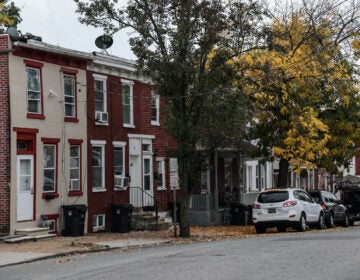U.S. Attorney General Loretta Lynch talks crime in Wilmington

U.S. Attorney General Loretta Lynch talks about crime during a visit to Wilmington. (Zoë Read/WHYY)
U.S. Attorney General Loretta Lynch, under the invitation of U.S. Sen. Chris Coons, D-Delaware, visited Wilmington on Monday to discuss violent crime and juvenile justice in the state of Delaware.
Lynch and Coons visited the Wilmington Police Department during a roll call to witness new technology in action, toured the New Castle County’s Children’s Advocacy Center and hosted a community discussion at the Delaware Historical Society focused on juvenile justice.
The political leaders highlighted the ways they believe crime has improved in Wilmington due to its participation in the Violence Reduction Network, and discussed ways to prevent crime in the city.
While rates of gun violence in Wilmington remain steady, Coons and Lynch say several strides have been made in the area of law enforcement.
“The shooting numbers, homicide numbers, have not yet come down, but the kinds of changes in the approach to policing, to investigation and solving homicides there’s been significant improvement,”Coons said.
The CDC reported there were 127 shootings and 154 victims in Wilmington in 2013, which was a 45 percent increase in shootings over two years. In 2014, Wilmington joined the VRN, along with several other cities with violent crime rates seven times the national average.
As of December 14th of this year, there were 124 shooting incidents with 139 victims, according to the Wilmington Police Department.
The U.S. Department of Justice launched the network to partner with communities facing violent crime issues and provide resources to decrease violent crime rates. On Monday, Lynch said joining the network is a “lottery no one wants to win.”
Wilmington has graduated from the network and now is in its sustainability phase. The city has even been asked to mentor other cities joining the network.
In 2014, only about 10 percent of homicides were solved, which Lynch said was a major concern for the network. She said part of the problem may have been due to a lack of trust between communities and law enforcement.
“We don’t have witnesses, we don’t have victims’ families coming forward, you also may not have the infrastructure in the police department to gather appropriate intelligence and information to see the patterns of criminal behavior, to track individuals.” Lynch said. “You also may not have a connection between local law enforcement and federal law enforcement, when federal law enforcement can target criminal actors with different laws with different types of punishments.”
She said today, the homicide closure rate has increased by 40 percent, which she credits to the VRN.
“(It) gives families closure, it lets communities see when community members suffer homicide law enforcement will pay attention,” Lynch said.
“When I talk to community members who feel so disconnected and don’t feel law enforcement cares, one of the things they say is, ‘Anything could happen and someone could come in and harm us and nobody would care.’ When you raise the homicide closure rate you change that perspective.”
Coons said law enforcement has more training opportunities and resources available to them to solve crimes and more successfully prosecute.
There also are increased multi-party cases solved through partnerships with other agencies, and Delaware’s involvement in the High Intensity Drug Trafficking Area has helped local law enforcement solve cases of large drug dealing operations.
Coons added that Delaware has received about $2.5 million in funding and Wilmington has received between $1.5 and $2 million dollars in funding from the federal government to reduce crime.
Lynch said updated technology within law enforcement, such as Wilmington’s new Real-Time Crime Center, and collaborations with federal agencies, are making a difference. However, homicides will not decrease overnight, she said.
“When you talk about entrenched systems of violence, long-term gang problems or people traveling in and out because they perceive an area is vulnerable, they perceive an area is available to them to engage in criminal activity, that’s a long-term focus. That’s when you start to focus on intelligence, on gathering information; who are the criminal actors? Where coming from? What organizations are they part of? How can we attack them systemically? And that’s what we’re still working on with the Wilmington Police Department,” she said.
“It is a work in progress and they recognize that and we recognize that.”
Prior to touring the Wilmington Police Department and the New Castle County Children’s Advocacy Center, Lynch and Coons discussed the importance of funding various youth programs and prevention initiatives, and the need for reentry programs and increased expungements for ex-offenders.
Lynch said in order to reduce homicides Delaware needs to discern specific causes of crime, such as drug and gang activity.
“Being able to figure out the root causes of violence is key in targeting a solution and intervene if you can, particularly if we’re talking about juveniles with easy access to guns, how can we reach them before they get involved in gang activity, how can we reach them before they decide pick up a gun is the way to resolve a problem, or is it an established older group of gang members? That’s a different approach,” she said.
WHYY is your source for fact-based, in-depth journalism and information. As a nonprofit organization, we rely on financial support from readers like you. Please give today.





